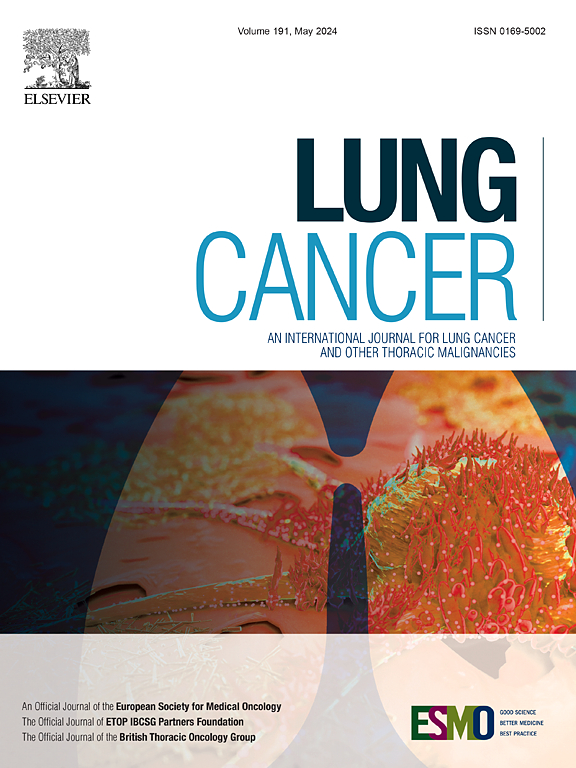The survival analysis of stage III and IV inoperable lung large cell neuroendocrine carcinoma and the role of LIPI in immunological stratification
IF 4.4
2区 医学
Q1 ONCOLOGY
引用次数: 0
Abstract
Background
Large cell neuroendocrine carcinoma (LCNEC) represents a rare and unique type of lung tumor with an unfavorable prognosis. It is essential to summarize the treatment modalities and prognosis for inoperable stage III and IV LCNEC, explore the role of frontline immunotherapy, and examine the stratification role of the Lung Immune Prognostic Index (LIPI) and its relationship with the tumor microenvironment (TME).
Methods
This study retrospectively analyzed 160 patients with inoperable lung LCNEC (L-LCNEC) admitted to three hospitals from December 2012 to November 2023. We evaluated the effects of different systemic treatment modalities on prognosis and explored independent prognostic factors, establishing models incorporating blood indicators. Furthermore, the study aimed to assess the association of the LIPI with overall survival (OS), progression-free survival (PFS), and objective response rate (ORR) in patients receiving immune checkpoint inhibitors (ICIs).
Results
Patients receiving frontline immunotherapy had significantly higher ORR (52.0 % vs. 24.7 %, p < 0.001), PFS (6.33 vs. 2.93 months, p = 0.033) and OS (21.3 vs. 12.9 months, p = 0.034). Independent protective factors for OS included frontline immunotherapy (p = 0.008) and CK positive expression (p = 0.033), while poor LIPI (p = 0.023), ≥3 metastatic sites (p = 0.005), positive CgA expression (p = 0.016), and DD-2 ≥ 5.0 (p < 0.001) were identified as independent risk factors. A prognostic model based on these factors had an AUC of 0.749. Significant differences in median PFS (mPFS) and median OS (mOS) were observed among the good, intermediate, and poor LIPI groups (p < 0.05). Multiple immunofluorescence staining revealed that the good LIPI group exhibited greater infiltration of immune cells marked by CD3 antibody.
Conclusion
This study highlights the benefit of frontline immunotherapy and the importance of LIPI in prognosis stratification, especially in identifying patients with limited treatment benefit.
III期和IV期不能手术的肺大细胞神经内分泌癌的生存分析及LIPI在免疫分层中的作用
背景:大细胞神经内分泌癌(LCNEC)是一种罕见而独特的肺部肿瘤,预后不良。总结不能手术的III期和IV期LCNEC的治疗方式和预后,探讨一线免疫治疗的作用,探讨肺免疫预后指数(LIPI)的分层作用及其与肿瘤微环境(TME)的关系。方法回顾性分析2012年12月至2023年11月在三家医院收治的160例不能手术的肺LCNEC (L-LCNEC)患者。我们评估了不同的全身治疗方式对预后的影响,并探讨了独立的预后因素,建立了纳入血液指标的模型。此外,该研究旨在评估LIPI与接受免疫检查点抑制剂(ICIs)患者的总生存期(OS)、无进展生存期(PFS)和客观缓解率(ORR)的关系。结果接受一线免疫治疗患者的ORR (52.0% vs. 24.7%, p < 0.001)、PFS (6.33 vs. 2.93个月,p = 0.033)和OS (21.3 vs. 12.9个月,p = 0.034)均显著高于一线免疫治疗患者。OS的独立保护因素包括一线免疫治疗(p = 0.008)和CK阳性表达(p = 0.033),而LIPI差(p = 0.023)、≥3个转移部位(p = 0.005)、CgA阳性表达(p = 0.016)和DD-2≥5.0 (p < 0.001)被确定为独立危险因素。基于这些因素的预后模型的AUC为0.749。LIPI良好组、中等组和较差组的中位PFS (mPFS)和中位OS (mOS)差异有统计学意义(p < 0.05)。多次免疫荧光染色显示,良好的LIPI组CD3抗体标记的免疫细胞浸润较多。结论本研究强调了一线免疫治疗的益处以及LIPI在预后分层中的重要性,特别是在识别治疗获益有限的患者方面。
本文章由计算机程序翻译,如有差异,请以英文原文为准。
求助全文
约1分钟内获得全文
求助全文
来源期刊

Lung Cancer
医学-呼吸系统
CiteScore
9.40
自引率
3.80%
发文量
407
审稿时长
25 days
期刊介绍:
Lung Cancer is an international publication covering the clinical, translational and basic science of malignancies of the lung and chest region.Original research articles, early reports, review articles, editorials and correspondence covering the prevention, epidemiology and etiology, basic biology, pathology, clinical assessment, surgery, chemotherapy, radiotherapy, combined treatment modalities, other treatment modalities and outcomes of lung cancer are welcome.
 求助内容:
求助内容: 应助结果提醒方式:
应助结果提醒方式:


